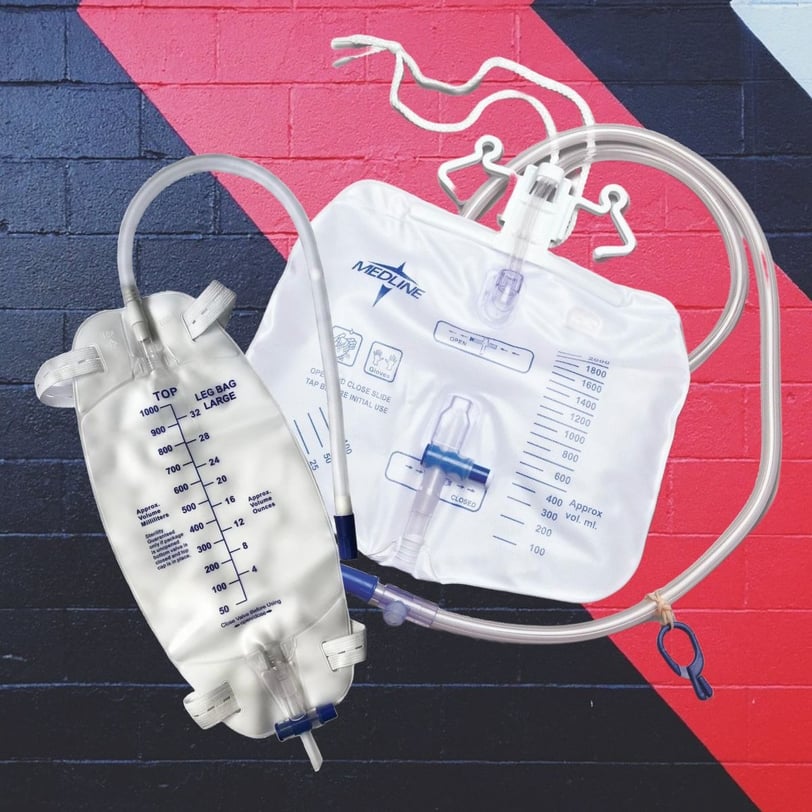
Indwelling Catheters 101: Essential Foley Catheter Care for New Caregivers and Families
Learn everything about indwelling catheters, from types and function to essential care practices and tips for family caregivers. This guide provides a clear understanding of managing these devices safely and effectively.
INCONTINENCE CARE
Introduction
Caring for someone with an indwelling catheter can seem tricky at first, but with the right knowledge, it becomes much easier to manage. Whether you're helping a loved one or learning for yourself, understanding how these catheters work and how to care for them is the first step toward keeping things comfortable and safe. This guide will walk you through the basics of indwelling catheters, including how they help, the types available, and the best ways to look after them. By the end, you'll feel more confident and prepared, knowing exactly what to do to avoid infections and keep things running smoothly.
Table of Contents
Understanding Indwelling Catheters
What are Indwelling Catheters?
Medical Uses for Indwelling CathetersThe Essentials of Indwelling Catheter Care
Hand Hygiene Practices
Catheter Insertion Site Care
Drainage Bag ManagementPreventing Catheter-Associated Urinary Tract Infections (CAUTIs)
Signs and Symptoms of CAUTI
Best Practices for Infection ControlEssential Equipment for Indwelling Catheter Care
Changing & Cleaning Drainage Bags: Keeping Things FreshCaring for a Loved One with an Indwelling Catheter
Creating a Supportive Home Environment
Managing Everyday Activities with an Indwelling Catheter: Concerns and Practical Solutions


Tom, a veteran recovering from surgery, deals with chronic pain while managing his indwelling catheter. With the help of physical therapy, he learns to cope with both conditions effectively.
Understanding Indwelling Catheters
Let's talk about indwelling catheters – those tubes that help drain urine from the bladder when someone can't do it on their own. They might sound intimidating, but they are actually quite common and play a vital role in managing various health conditions.
What Are Indwelling Catheters (Foley, Coude) and Their Purpose?
Think of an indwelling catheter as a tiny straw that gently sits inside the bladder, allowing urine to flow out continuously into a drainage bag. There are two main types: Foley catheters and Coude catheters.
Foley Catheters: These are the most common type, with a balloon at the tip that inflates inside the bladder to hold it in place. Imagine a tiny water balloon keeping everything secure!
Coude Catheters: These have a slightly curved tip designed for men who might have an enlarged prostate or other anatomical challenges. Think of it like a gentle bend helping navigate around obstacles.
Indwelling catheters are used for several reasons:
Urinary Retention Relief: Sometimes, the bladder doesn't empty properly due to blockages, nerve problems, or surgery. A catheter can provide relief and prevent discomfort.
Surgical Necessity: During and after certain surgeries, a catheter helps monitor urine output and ensures the bladder stays empty while you recover.
Severe Incontinence Management: For individuals with long-term incontinence (difficulty controlling urination), a catheter can offer a solution for managing leaks and maintaining hygiene.
The Essentials of Indwelling Catheter Care: Keeping Things Clean & Safe
Just like any medical device, keeping your indwelling catheter clean is crucial to prevent infections. Think of it as protecting the gateway between your body and the outside world!
Hand Hygiene Practices: Your First Line of Defense
Washing your hands thoroughly before and after touching anything related to the catheter (the tube itself, drainage bag connections) is essential. Use soap and water for at least 20 seconds – sing "Happy Birthday" twice to make sure you're scrubbing long enough!
Catheter Insertion Site Care: Gentle Cleaning Makes a Difference
The area where the catheter enters your body needs daily cleaning with mild soap and water. Think of it like giving that spot a gentle spa treatment. Pat it dry afterwards – no rubbing, as this can irritate the skin.
Drainage Bag Management: Keeping Things Flowing Smoothly
Positioning: The drainage bag should always be lower than your bladder to allow gravity to do its job and prevent urine from flowing back up into the bladder. Imagine a gentle downhill slope for the urine!
Emptying: Empty the bag when it's about half or two-thirds full (every 4-8 hours) using clean gloves to avoid contamination. Think of it like taking out the trash – you wouldn't want it overflowing, right?
There are different types of drainage bags:
Leg Bags: These smaller bags are great for daytime use and allow for more mobility.
Night Bags: Larger capacity bags designed for overnight use while you sleep soundly.


Leg Bag and Night Bag
Preventing Catheter-Associated Urinary Tract Infections (CAUTIs): Staying Vigilant
While catheters are helpful, they can sometimes lead to urinary tract infections (UTIs). Think of it like a potential side effect that we need to be aware of and take steps to prevent.
Signs & Symptoms: Be on the lookout for redness, swelling, pain around the catheter insertion site, fever, or cloudy/smelly urine – these could indicate an infection brewing.
Best Practices for Infection Control: Teamwork Makes the Dream Work!
Hand hygiene is your superpower against infections! Regular cleaning of the catheter insertion site and monitoring for any signs of trouble are also crucial. Remember, early detection is key to preventing complications.
Essential Equipment for Indwelling Catheter Care: Gearing Up
Caring for an indwelling catheter requires a few essential tools:
Catheterization Packs: These handy packs contain sterile gloves, drapes (to create a clean work area), and lubricant – everything you need for safe insertion or changes.
Drainage Bags: We already talked about leg bags and night bags!
Cleaning Supplies: Mild soap, washcloths, towels, alcohol wipes, or antiseptic solutions are your cleaning allies.
Caring for a Loved One With an Indwelling Catheter: Empathy & Empowerment
Having a loved one with an indwelling catheter can raise questions and concerns, but remember that you're not alone in this journey. Open communication is key – talk to your loved one about their feelings and address any anxieties they might have.
Building Confidence Through Education
Empowering your loved one with knowledge about the catheter and care process can make a big difference. Explain how it works, why it's necessary, and what steps are involved in keeping things clean and safe.
Creating a Supportive Home Environment: Dignity & Independence Matter
Remember that having an indwelling catheter doesn't mean losing independence or dignity! Simple adjustments like privacy screens during care procedures can make a big difference. Encourage your loved one to participate in daily activities as much as they feel comfortable, reminding them that life goes on even with this medical device.
Daily Living With an Indwelling Catheter: Finding Your Rhythm
With proper care and attention, people can maintain normal routines while using an indwelling catheter – work, exercise, intimacy are all still possible! Just remember to follow your healthcare provider's instructions carefully and be vigilant for any signs of trouble.
Managing Everyday Activities with an Indwelling Catheter: Concerns and Practical Solutions
Tips For Family Caregivers: Sharing the Load & Avoiding Burnout
Caring for a loved one is a rewarding but demanding task. Remember that you don’t have to do it all alone!
Sharing Responsibilities: Delegate tasks within your family or circle of support – maybe someone else can handle grocery shopping while you focus on catheter care.
Seeking Respite Care Options: Don’t hesitate to reach out for professional help when needed, even if it’s just for a few hours each week. Respite care gives caregivers a much-needed break and prevents burnout.


John, a father with severe incontinence, finds relief and hope through the use of a Foley catheter, allowing him to enjoy life with his family again.
Navigating Medical Professionals & Resources: Asking the Right Questions
Your healthcare provider is your partner in managing this condition! Don't be afraid to ask questions about catheter care, medication options (to prevent complications), or any concerns you might have.
Remember that nurses are a valuable resource for support and guidance – they often have firsthand experience with indwelling catheters and can offer practical tips.
Additional Support For Family Caregivers: You Are Not Alone!
Connecting with others who understand your journey can be incredibly helpful. Look into online forums or local support groups where you can share experiences, ask questions, and find encouragement.
Financial assistance programs like Medicare and Medicaid may also cover the costs of catheter supplies – don't hesitate to explore these options.
Taking care of a catheter can feel a bit overwhelming at first, but staying informed, talking openly with doctors, and checking in regularly can make a huge difference. Remember, it's okay to ask for help and learn as you go. For more tips and guidance, check out trusted resources like the Urology Care Foundation or the CDC. They have great information to help you along the way!
References and Further Reading
To help you further explore the topics covered in this guide, we've gathered reputable resources that provide in-depth information on indwelling catheter care. These references offer valuable insights into the medical necessity, proper care practices, and important hygiene techniques to ensure safety and comfort. Whether you're a caregiver or someone using a catheter, these sources will give you the knowledge needed to manage catheter care confidently and effectively.
Overview of Indwelling Catheters and Their Medical Necessity
Reference: “Indwelling Catheter Definition & Types.” UroToday,
Description: This source provides a comprehensive definition of indwelling catheters, including their medical necessity for conditions like urinary retention and incontinence.Defining Indwelling Catheters (Foley, Coude) and Their Purpose
Reference: “Foley Catheter: Purpose, Insertion & Care.” Cleveland Clinic,
Description: This article explains the purpose and types of indwelling catheters, specifically Foley and Coude catheters, and their usage in draining urine and managing urinary conditions.Medical Uses for Indwelling Catheters
Reference: “Uses and types of urinary catheter” Medical News Today,
Description: This source outlines the various medical uses for indwelling catheters, including urinary retention relief, surgical necessity, and severe incontinence management.Types of Indwelling Catheters
Reference: “Urinary Catheters: Uses, Types, and Complications.” Healthline,
Description: This article provides detailed information on the different types of indwelling catheters, including Foley and Coude catheters, and their specific features and benefits.Hand Hygiene Practices
Reference: “Indwelling Urinary Catheter Insertion and Maintenance.” CDC,.
Description: This document emphasizes the importance of hand hygiene and sterile techniques in preventing infections during catheter care.Preventing Catheter-Associated Urinary Tract Infections (CAUTIs)
Reference: “Clinical Safety: Preventing Catheter-associated Urinary Tract Infections (CAUTIs).” CDC,
Description: This source provides guidelines and best practices for preventing CAUTIs, including the importance of hand hygiene and aseptic techniques.Essential Equipment for Indwelling Catheter Care
Reference: “Urinary Catheter Management.” AAFP,
Description: This article discusses the essential equipment needed for indwelling catheter care, including catheterization packs, drainage bags, and cleaning supplies.Essentials of Indwelling Catheter Care
Reference: Nursing Center. “Frequency for Changing Long-Term Indwelling Urethral Catheters” Nursing Center, 2016,
Description: This article provides comprehensive guidelines on the care and maintenance of indwelling urinary catheters, emphasizing infection prevention and best practices.
Reference: NCBI. “Canadian Urological Association Best Practice Report: Catheter use.” National Center for Biotechnology Information, 2020,
Description: This article discusses the various aspects of urinary catheter care, including indications for use, complications, and recommended care practices.
Reference: WRHA. “Urinary Catheter Change Frequency, Infection Prevention and Control Communication Form.” Winnipeg Regional Health Authority, 2016,
Description: This document outlines the recommended frequency for changing urinary catheters in continuing care settings, based on clinical guidelines and evidence-based practices.
Reference: eHealth Saskatchewan. “Frequency of Long-Term Urinary Catheter Replacement in Continuing Care Settings.” eHealth Saskatchewan, 2016,
Description: This resource provides guidelines on the frequency of long-term urinary catheter replacement, focusing on patient safety and infection control.
Reference: Universal Med Supply. “How Often Should Catheters Be Changed?” Universal Med Supply, 2021
Description: This article discusses the recommended intervals for changing different types of catheters, including indwelling, suprapubic, and intermittent catheters.Caring for a Loved One with an Indwelling Catheter
Reference: “Care for an Indwelling Urinary Catheter.” ColumbiaDoctors,
Description: This source provides practical tips for caregivers on how to care for a loved one with an indwelling catheter, addressing emotional concerns and building confidence.


Linda, a home caregiver for her elderly mother, struggles with balancing catheter management duties alongside her job. She finds a local support group for caregivers that helps her navigate this new challenge.
FAQs: Indwelling Catheter Care
How often should an indwelling catheter be changed?
Typically, an indwelling catheter should be changed every 4 weeks by a healthcare professional. However, this can vary depending on individual medical needs, so always consult with your doctor.
How do I prevent infections while using a catheter?
Proper hygiene is key. Always wash your hands before and after handling the catheter, clean the insertion site daily with mild soap and water, and make sure the drainage bag stays below bladder level to prevent backflow.
What are the signs of a catheter-related infection?
Signs of infection include fever, chills, cloudy or smelly urine, redness or swelling around the insertion site, and pain. If you notice any of these, contact your healthcare provider right away.
Can I still shower with an indwelling catheter?
Yes, you can shower with a catheter, but avoid soaking in baths. Make sure to clean the area around the catheter with soap and water, then dry it thoroughly afterward.
How often should I empty the drainage bag?
You should empty the drainage bag when it is about 1/2 to 2/3 full, or every 4 to 8 hours. Always use clean gloves and wash your hands before and after.
Can I return to normal activities with an indwelling catheter?
Yes, most people can continue their normal activities like work, exercise, and sexual intimacy while using an indwelling catheter. Just be sure to follow your doctor’s care instructions.
What should I do if the catheter gets blocked?
If you suspect a blockage (e.g., the drainage bag isn't filling), check for kinks in the tubing. If there’s no obvious issue, contact your healthcare provider to avoid complications.
Empowering Care with Knowledge
Caring for a loved one with an indwelling catheter can feel overwhelming at times, but remember – the more you know, the more confident you’ll be. By learning how to properly care for the catheter and being aware of potential issues like infections, you’re playing a vital role in ensuring their comfort, health, and safety.
Still have questions about managing indwelling catheters? Feel free to ask in the comments below – we're here to learn and support one another. And if you found this guide helpful, don’t forget to share it with others who might benefit from this valuable information!
Related Article
More for you



